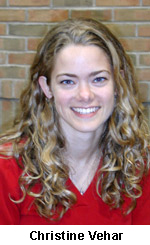Most new graduate students will rely on personal funds or loans to see them through graduate school – but a special few are fortunate to start their research with singular financial assistance. This is the case for graduate students Rachel Collino and Christine Vehar, who have been awarded highly-competitive and prestigious National Science Foundation (NSF) Graduate Research Fellowships ( http://www.nsf.gov/dir/index.jsp?org=EHR ).
Under this program, NSF provides up to three years of funding, including a $27,500 stipend and $10,500 cost-of-education allowance per year, in the form of a fellowship for students “in the early stages of graduate study in science, mathematics, or engineering.” At U-M, Rackham Graduate School makes up the remainder of tuition. More than 6,500 applicants compete for fewer than 1,000 fellowships each year in 20 different disciplines.
In addition to standard information such as GRE scores and field of study, applicants must submit a Proposed Plan of Research and a Previous Research Experience Form. A panel of scientists, mathematicians, and engineers evaluates each application by answering two questions:
* What is the intellectual merit of the applicant?
* What are the broader impacts of supporting the individual’s graduate study?
Collino’s plan of research focuses on using functionally graded materials (FGMs) to improve artificial hip joints. At first, her proposal was going to focus on composite materials, but then she began learning about FGMs.
 “I had been doing a lot of research for ME450 [Senior Capstone Design class], for which we had a biomedical project. This steered my thinking a bit more to how FGMs could be a much better material replacement for implants, etc.,” she said. “I ended up scrapping my old proposal and giving myself a crash course in FGMs.” She finished the new proposal just a few days before the application deadline.
“I had been doing a lot of research for ME450 [Senior Capstone Design class], for which we had a biomedical project. This steered my thinking a bit more to how FGMs could be a much better material replacement for implants, etc.,” she said. “I ended up scrapping my old proposal and giving myself a crash course in FGMs.” She finished the new proposal just a few days before the application deadline.
“An application of functionally gradient materials that I find especially interesting is their use in various biomedical applications,” she wrote in her proposal. “In joint implants, for example, FGM properties are useful in mimicking natural bone, a functionally graded composite itself.”
One problem frequently encountered in implants is that the stiffer material of the implant tends to carry the majority of load on the bone. According to her proposal, this produces “a reduction in compressive stresses natural to the bone,” leading to bone loss and the eventual loosening of the implant. In artificial hip joints, failure specifically relates to particles that are produced by the rubbing of the joint material. These particles are similar in size to bacteria that the immune system attacks, and, her proposal says, “Chemical processes due to the activity of the immune system then break down the surrounding bone, initiating failure of the artificial joint.”
Collino proposed first to study wear behavior of biocompatible materials, such as hydroxyapatite or bioglass, to determine if these would serve as a suitable coating for hip implants to eliminate the offending particles; and second, to “compare the particle wear rate and size to those produced by the metals traditionally used.” The research, she said, would apply not only to joint implants but also to implants connected directly to the bone, “exploiting the desirable properties of the biocompatible material while also prolonging the service life of the artificial joint.”
Collino, currently in her first year of graduate studies, received her BSE from ME in April 2003 and is working toward a PhD. For the past two summers, she has held internships with Whirlpool Corporation Research and Engineering Center in Benton Harbor, Michigan. She credits her advisor, Professor Michael Thouless, and fellow PhD student Matt Cavalli for helping to prepare her to apply for graduate schools and fellowships.
Vehar’s research plan begins by observing that humans typically construct mechanisms “as strong, rigid assembled bodies, while for millennia nature has constructed mechanisms as strong, flexible, integrated bio-components.”
 She proposed that, “medical applications, such as the cleverly intrinsic, multi-part prosthetic devices and artificial organs, can be astronomically improved if redesigned as biologically inspired compliant mechanisms.”
She proposed that, “medical applications, such as the cleverly intrinsic, multi-part prosthetic devices and artificial organs, can be astronomically improved if redesigned as biologically inspired compliant mechanisms.”
Specifically, her research plan aims to “unlock nature’s design rules of thumb” by investigating the topology, torsionality, bending, rigidity, and compliance of bio-structures such as tree trunks and squid arms and tentacles; to capture these as mathematical design constraints; and to illustrate the new constraints by redesigning a prosthetic knee as a compliant mechanism. Using the knowledge gained from this research, a “new, automated optimization scheme for compliant mechanism creation” could be developed.
Vehar, currently in her second year of graduate studies, received her BS from the University of Dayton, Ohio, in May 2002 and is also working toward a PhD. As an undergraduate, she held a co-op with an aerospace company, as well as an internship in Washington, D.C. for engineers interested in policy. Her advisor is Professor Sridhar Kota.
Both women have expressed an interest in becoming educators, but Collino also has her eye on industrial R&D and Vehar’s experiences have given her a desire to influence policy.
“I know I can’t do everything,” Vehar said. “But I know my talents, and I want to improve them as much as I can. I love problem-solving.”